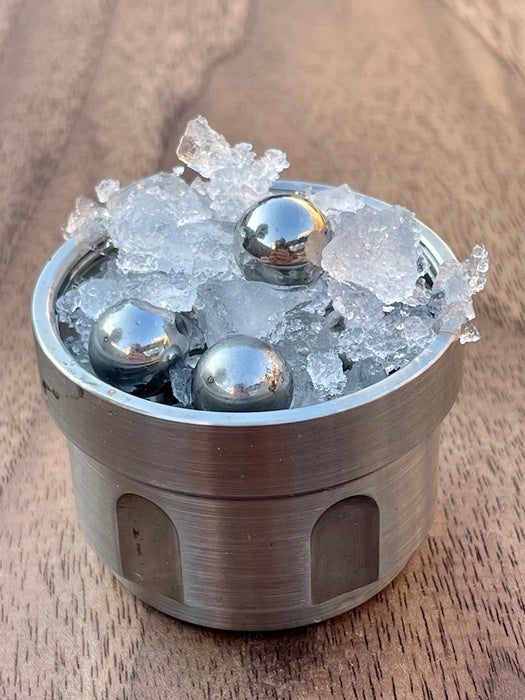Chemists have discovered a new form of ice, and their work may have major consequences for our understanding of the outer solar system.
We usually encounter three forms of water on the surface of Earth: solid, liquid, and vapor. On our planet, solid ice mainly comes in one variety, where water molecules arrange themselves into an orderly and repeated crystalline structure. But scientists have discovered 19 other varieties of water-ice that may appear throughout the universe.
One class of of ice does not rely on repeated structures at all. This is called amorphous ice. And scientists have known for decades of two kinds, called low-density and high-density amorphous ice.
But recently, a team of chemists took an extremely simple experimental setup and created an entirely new form of amorphous ice, which they called medium-density amorphous (MDA) ice.
To create the new ice, the team put ice chilled to –340 degrees Fahrenheit (–255 Celsius) into a container with small steel balls. They then used a machine to vigorously shake the container back and forth 20 times per second.
Lead author Alexander Rosu-Finsen of the University College London said in a press release, “We shook the ice like crazy for a long time and destroyed the crystal structure. Rather than ending up with smaller pieces of ice, we realized that we had come up with an entirely new kind of thing, with some remarkable properties.”
Senior author Christoph Salzmann, also at the University College London, said, “Water is the foundation of all life. Our existence depends on it, we launch space missions searching for it, yet from a scientific point of view it is poorly understood.
“We know of 20 crystalline forms of ice, but only two main types of amorphous ice have previously been discovered, known as high-density and low-density amorphous ices. There is a huge density gap between them, and the accepted wisdom has been that no ice exists within that density gap. Our study shows that the density of MDA is precisely within this density gap and this finding may have far-reaching consequences for our understanding of liquid water and its many anomalies.”
A paper detailing the creation and properties of the medium-density amorphous ice was published Feb. 2 in the journal Nature.
The importance of amorphous ice
Amorphous ice may be the most common form of ice in the universe, as the conditions to create ice with regular, repeated structure may only exist in special places like the surface of Earth. So, most comets and the outer moons of the solar system may be packed with amorphous ice — though astronomers have yet to prove it.
The problem is that from a great distance, amorphous ice looks a lot like normal ice. And when comets come close enough for us to observe them in detail, their surfaces evaporate from the Sun’s radiation, preventing us from learning what kinds of ices they contain.
The researchers found that when they warmed up MDA, it turned back into a regular crystal lattice, releasing a surprising amount of heat. Since MDA has nearly the same density as water, this could have huge implications for the nature of the frozen moons like Europa and Ganymede.
Those worlds are thought to have thick ice shells surrounding globe-spanning oceans of liquid water. And since liquid water is a requirement for life as we know it, these are the worlds that stand as prime candidates to search for signs of past or present life.
However, these moons are also completely alien, and their distance from the Sun and cold temperatures mean that the chemistry of their ice and water is different than what it is on Earth. For example, sudden shifts in temperature could quickly melt MDA, triggering tectonic motions in the moons’ giant ice sheets and completely altering the ice-liquid boundaries in their interiors.
Searching for ice in the solar system
Ultimately, the only way to study the nature of water on these distant worlds is to go there. The European Space Agency’s Jupiter Icy Moons Explorer (JUICE) mission is set to launch on April 13, 2023, and it will settle into an orbit around Jupiter in 2031. That will allow it to closely study the fascinating moons Europa and Ganymede. NASA will quickly follow up on that mission with its own, Europa Clipper, set to launch in 2024.
Those missions won’t just search for signs of life. They will also be able to closely study whatever forms of ice cover the moons, as well as sample plumes of water-ice that occasionally erupt from Europa’s surface.
If the forms of ice on those moons match that of MDA, then we will have to continue research into this strange new form of ice to better understand the conditions — and potential habitability — of the moons in the outer solar system.










